I Bought an Island in Cambodia and Changed My Life
How
does travel change your life? In this Yahoo Travel series, we get the
low-down on the transformative power of travel, along with all your tips
and strategies. If you’ve got a story that you think Yahoo Travel
should spotlight, tweet us using the hashtag #RealTravel or email
traveleditors@yahoo.com.
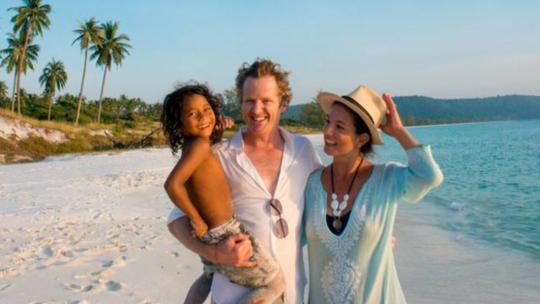
Melita Koulmandas Hunter, her husband Rory, and their son Naryth. (Photo: Melita Koulmandas Hunter)
Who: Melita Koulmandas Hunter, co-owner of Song Saa, a stunning private-island resort in Cambodia
Where: Cambodia
Why: My
husband and I moved to Cambodia in 2005 for a 12-month adventure and
ended up staying 10 years. We are both originally from Sydney,
Australia, and met in Auckland, New Zealand, where Rory was working at
Saatchi and Saatchi, and I had my own organic design business. We fell
in love and planned on moving to New York City together. Just before we
moved, Rory was offered an opportunity to run an advertising agency in
Phnom Penh. As a designer, I have always been drawn to Southeast Asia,
so we decided to take 12 months out and have an adventure, before taking
on the bright lights of New York City. Ten years later, we haven’t
moved to NYC…yet.
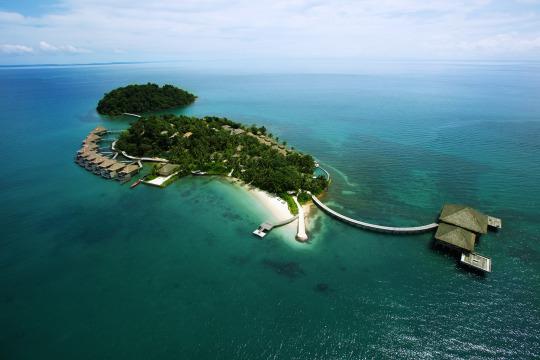
An aerial view of Song Saa, the resort that Melita Koulmandas Hunter built with her husband in Cambodia.
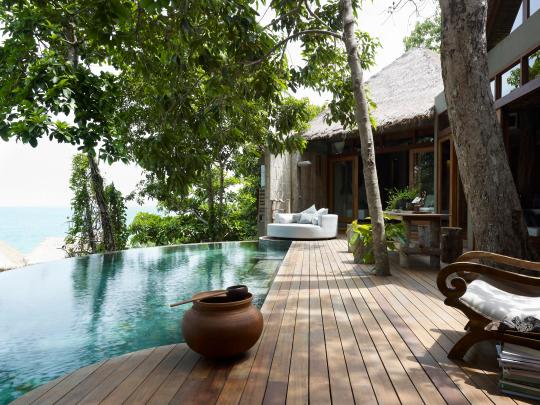
A villa at the resort.
What I Loved: The
red soil, contrasting with the lush green foliage in the monsoon
season. The tropical thunder storms, the people, their smiles, the
abundant energy of youth, and the positive change happening in the
country after such a tumultuous past.
When We First Arrived: The
country was in the process of picking up the pieces after the war.
There were no traffic lights, no paved roads, no ATM machines, and
virtually no cars on the road; cyclos, tuk tuks, and motor bikes where
the dominant modes of transport. Seventy percent of the population was
under the age of 30. In our first six months in Phnom Penh, we saw so
much change — the first traffic lights went up near the airport, paved
roads were laid, cars started coming onto the roads, buildings started
going up across town, and all around, the young people were talking
about getting educated and catching up to the rest of Asia. There was
such an incredible positive energy in the air of moving forward out of
Cambodia’s dark history.

Exploring one of the beaches in the Koh Rong archipelago (Photo: Song Saa)
The Beginnings: During
our first year in Cambodia, while Rory ran the agency, I started a
small business in landscape design, and was being offered contracts for
art gallery spaces that were starting to open up, as well as cafes,
restaurants, and private gardens. In 2006, we set up a land-holding
company that would allow us to buy, sell, and develop land. We had no
detailed plan for what we were going to do, we just knew that we had
fallen in love with Cambodia and its people and wanted to create
something special together. So we just opened ourselves to
opportunities.
The Life-Changing Experience:
In January 2006, a Khmer friend whose father-in-law was a fisherman
told Rory and me about some amazing islands with virgin rainforest and
pure white sand beaches 18 miles off the coast of Cambodia. The only
people there were fisherman. Rory and I went down to the coast and
rented a fishing boat and spent two weeks circumnavigating the Koh Rong
Archipelago.
The
experience was amazing — and life changing. We would jump off the boat
into crystal-clear water, make the first foot prints on the long,
deserted beaches. We were welcomed with openness by the locals and spent
time in the fishing villages. The locals had never seen a foreigner.
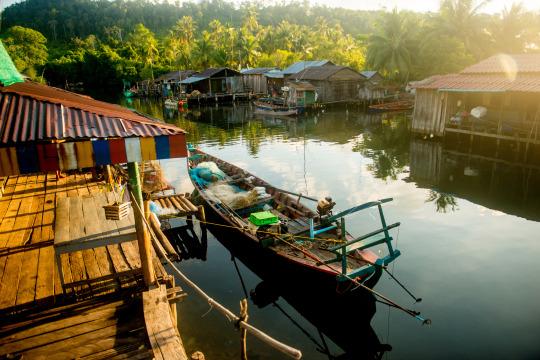
Fishing boats in Cambodia. (Photo: Song Saa)

A local village. (Photo: Song Saa)
On
the last day of our adventure, we stopped at the little island of Koh
Oun, looking for lunch. We met a family with a wholesale fishing
business who spoke of how things were changing, the waters were getting
overfished, and it was becoming harder and harder to feed their
families. They had land on the mainland and wanted to go back to rice
farming. The father asked us, “Do you want to buy my island?”
We paid the asking price: $15,000.
What Happened Next: We
returned to Phnom Penh and came back to the island the following week
with a brown paper bag full of money. Rory and I started to clean up the
little island. The reefs were dying due to the daily dumping of bilge
pumps and garbage by the 50 or so fishing boats that would park there
each day. The island itself had been cleared of rainforest and coconuts
had been planted, with the whole hillside impenetrable due to weeds.
There was 20 years of garbage just piled up and all kinds of mud and
waste from the pigs and the chickens that had been living there.
Rory and I guaranteed that any villager who wanted to stay on could do so and would have a job for life. Eight families stayed.
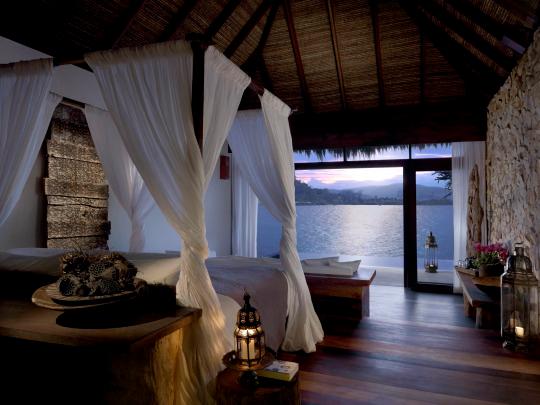
An overwater guest room at Song Saa. (Photo: Song Saa)
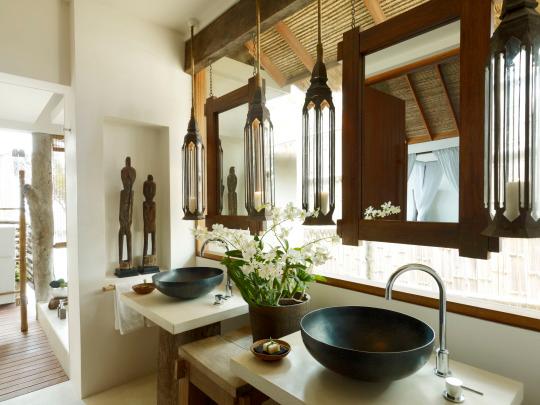
Details in a bathroom at Song Saa. (Photo: Song Saa)
The Creation of a Resort:
It took two-and-a-half years, hundreds of people, several mandates, and
a whole lot of blood, sweat, and tears, but we eventually designed and
built our dream: Song Saa Private Island. The resort is set on two
islands connected by a footbridge over a marine reserve and has
overwater, jungle, and oceanview villas built with sustainable materials
and with the deepest respect for the natural environment. I designed
the resort using many recycled materials: driftwood, wood from old
boats, scrap metal, stone.
Some
of the island’s original families have moved on with their new skills
and found work on the mainland, while some are still part of the Song
Saa family.
What Did You Learn? We
learned a great deal of respect for the culture, heritage, people, and
environment. From the start, environmental concerns were paramount. And
that meant not only the local ecology, but the human environment, too:
helping communities toward sustainable livelihoods, supporting village
rejuvenation, and cleaning up neighboring islands.
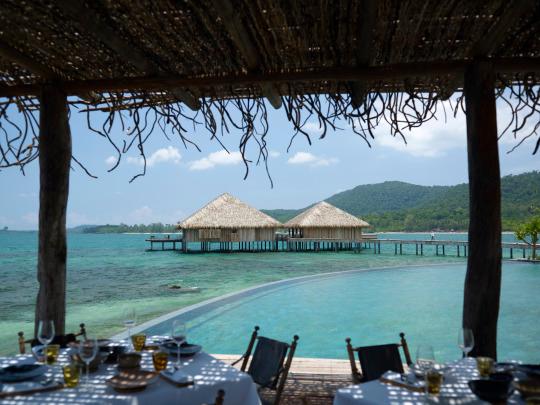
A view of the restaurant and the pool at Song Saa. (Photo: Song Saa)
In
the same year of buying the island (2006), the Song Saa Marine Reserve
was created. It features a no-fishing zone around the two islands of the
resort and as a result the area is now teeming with sea life.
In
2013, the Song Saa Foundation was established and has not only achieved
the creation of Cambodia’s first coral reef conservation reserve, and
increased it twice in size, but also an annual collaboration of the
largest medical outreach mission in the history of the Koh Rong
Archipelago.
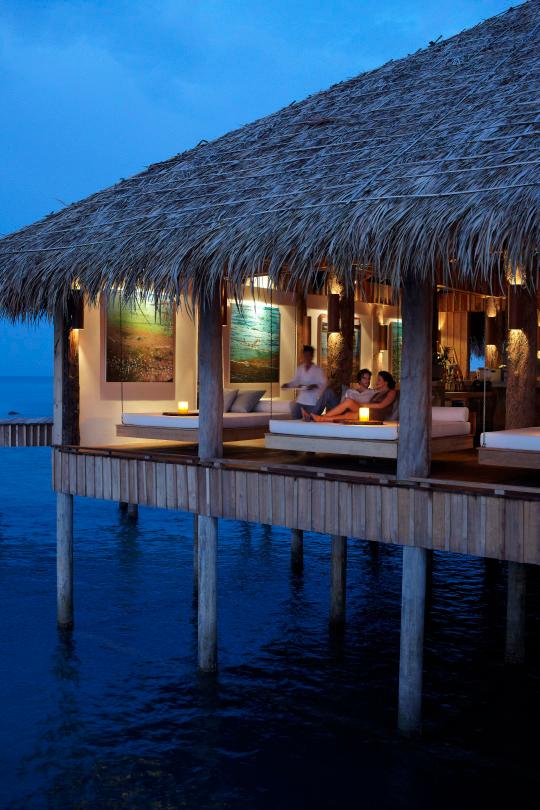
Song Saa’s overwater bar. (Photo: Song Saa)
It
was a great honor and privilege having Prince Albert of Monaco visit
Song Saa and award our foundation a grant from his own foundation, so
that we can build a scientific research lab for Marine Conservation
What I Love: I am very fortunate that my work opens
the doors to such extensive traveling and the opportunity to explore
Southeast Asia looking for artisans to work with, as well as going to
cities all over the world, for design shows, conferences, and meetings.
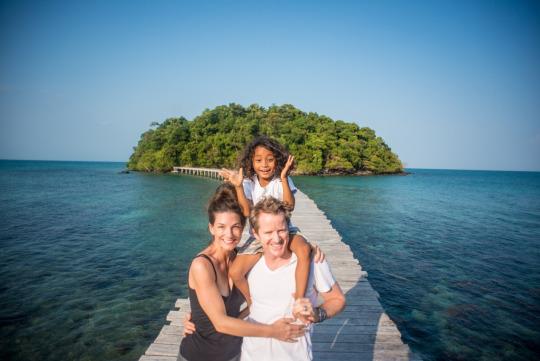
Melita, Rory, and Naryth. (Photo: Melita Koulmandas Hunter)
How the Experience Changed Me:
I am constantly growing, and evolving as we continue on this amazing
journey. There are so many highlights, however the biggest one of all
was adopting our Cambodian son, Naryth, who is such a joy in our lives.
Parting Thoughts: Follow your heart – no matter what you do.
WATCH: Visiting This Buddhist Nunnery is a Life Changing Experience
Let Yahoo Travel inspire you every day. Hang out with us on Facebook, Twitter, Instagram, and Pinterest. Check out our original adventure travel series A Broad Abroad.
Comments
Post a Comment